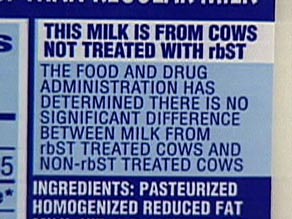Reading the label often starts with the front of the package. In the case of this product it allows you to skip the need to read the label altogether. As the graphic indicates, it's a cheese “product”, not really cheese. Sometimes you will see “cheese food” on the package. What's the difference? It turns out that to be declared a cheese food a product must be at least 51% cheese. If it is less than 51% cheese then it is classified as a cheese product. In both cases, cheese food and cheese product do not, in my book. qualify as cheese.
An important note, when purchasing cheese, or any other dairy product, you also want to avoid added hormones. This can be done by purchasing either organic dairy (the organic label does not allow for the use of artificial hormones in dairy production) or dairy products which are at least rBGH or rBST free. You can look it up or you can look on the label. Sometimes you will see the following statement on a dairy product

According to the Institute for Responsible Technology there are a number of companies that have pledged not to use this artificial hormone in their dairy products.

This is a positive step forward. As more consumers purchase milk that is free of added hormones, the more food producers and retailers will reject the use of this harmful additive. The hope is that eventually the United States will join countries like Canada, Japan, Australia, New Zealand, Israel, Argentina, and all of the countries in the European Union.
So read the front of the label, if it's not real cheese don't buy it. It if appears to be cheese, look at the rest of the label and make sure there are no added hormones.


